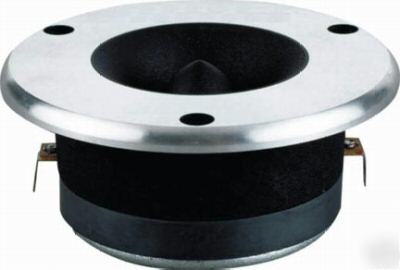Greater Tulsa Area Classifieds Moderated Newsgroup > Red Fork
> Automobiles
> 300 watt air ultrasonic transducer (4 phasor generator
300 watt air ultrasonic transducer (4 phasor generator
300-Watt Air ULTRASONIC TRANSDUCER.
This is a very versatile 300-Watt (peak power) ULTRASONIC TRANSDUCER. Has metal body and is about 4" big. Frequency range is 10kHz - 25kHz, and it can be powered directly from any extended Audio Power Amp.
All you need to make a Phasor Pain Field generator with this, is our Sweep IC, 5 volts to power it, and an extended audio power amp like this 240-watt one . And using the lowest sweep IC frequency is pretty much like LRAD, except it doesn't reach as far.
"[For] most people, even if they plug their ears, [the device] will produce the equivalent of an instant migraine," says Woody Norris, chairman of the San Diego firm that produces the LRAD(tm) weapon. "It will knock [some people] on their knees." The new megaphone being deployed to Iraq can operate at 145 decibels at 300 yards, according to American Technology, well above the normal threshold for pain. The company posts a scenario in which Al Qaeda terrorists would run screaming from caves after being subjected to a blast of high-decibel sound from the devices, their hands covering their ears. Here's a link with more info about LRAD(tm). 145 decibels at 300 meters - Ouch!
There is one more way to experiment with ultrasonic air transducers like this one, and that is to try replicate the effects of LRAD(tm). For that you'd need two transducers. LRAD(tm) works on a principle that when you cross two ultrasonic beams (say 20 and 25 kHz), you generate the difference between the two (5kHz sound) originating at the point where the two beams cross. Or you could use two same frequencies (23kHz and 23kHz) and FM modulate one of them with voice or audio. And another way of doing that is to phase-shift one of the 23kHz tones instead of frequency-modulating it. That delivers sound to long distances and makes it appear that the sound originates right next to you or inside your head, even though you're dozens of yards away from the transducers. And with more power, distances of hundreds of yards can be reached, which is what LRAD(tm) does.
The actual LRAD(tm) uses a sweeping frequency in weapon mode, which can be simulated using our Phaser Sweep IC chip (in animal control mode) driving one side of stereo power amp, and driving the other input with a steady frequency (like 25 kHz). Then connect two air ultrasonic transducers to outputs of the stereo amp, and you should hear the sweeping frequency at the point where the two ultrasonic beams cross.
And here's a short quote from New York Times magazine:
"Most of the sounds under military consideration are classified, but some are approved for public consumption. One truly harrowing noise is that of a baby crying, played backward, and combined with another tone.
Nimbly holding a big black plate, Norris stands with me in an A.T.C. sound chamber. "LRAD can instantaneously cause loss of equilibrium, vomiting, migraines - really, we can pretty much pick our ailment," he says brightly.
Norris prods his assistant to locate the baby noise on a laptop, then aims the device at me. At first, the noise is dreadful - just primally wrong - but not unbearable. I repeatedly tell Norris to crank it up (trying to approximate battle-strength volume, without the nausea), until the noise isn't so much a noise as an assault on my nervous system. I nearly fall down and, for some reason, my eyes hurt. When I bravely ask how high they'd turned the dial, Norris laughs uproariously. "That was nothing!" he bellows. "That was about 1 percent of what an enemy would get. One percent!" Two hours later, I can still feel the ache in the back of my head."
